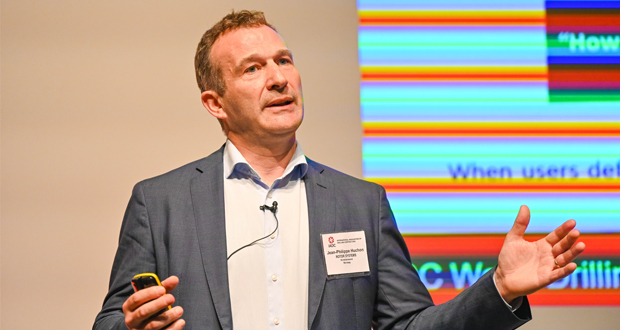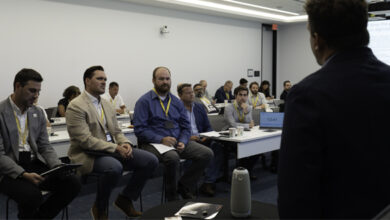New GreenDrill software targets higher granularity in measuring, analyzing rig equipment emissions
Cloud-based system, still under development, aims to enhance drilling contractors’ ability to document improvements in emissions footprint

By Stephen Whitfield, Associate Editor
A host of software systems available on the market allow drillers to measure and monitor emissions from the rig. However, many of them lack granularity in specifying which pieces of equipment have high-energy use and when, or predictive capabilities on how much energy could be generated by that equipment in the future, said Jean-Philippe Huchon, Project Manager at Stimline. This information, he said, could be critical in providing insight for future efforts to reduce emissions.
“We’re missing real information on the source of the emission. We can see how much fuel we’re using per day, per month, per year, but we need to see why we’re producing more or less emissions,” he explained. “It’s sometimes difficult to understand how much we can conserve. Is it worth it to build a business case around emissions reduction? We thought that something should be done here.”
Speaking at the 2023 IADC World Drilling Conference in London, Mr Huchon discussed GreenDrill, a cloud-based emissions monitoring and documentation system developed by Rotor Systems. Stimline, a software developer focused on well intervention, drilling and completions, and Rotor Offshore, an engineering services provider, jointly founded Rotor Systems last year.
GreenDrill uses sensors connected to the rig’s power generation systems and power distribution systems, as well as other systems, such as the mud pumps and the top drive, to collect power usage data. The energy consumption data gathered is then linked to the timeline of the well, creating better understanding of which equipment and drilling activity is using energy – and, therefore, generating emissions, at any given time.
Data is processed at the rig site using a proprietary edge server before being transferred to the software’s cloud computing platform for storage. Built-in algorithms are used to estimate the amount of CO2 equivalent (CO2e) emissions generated by each piece of equipment – and by the rig as a whole – along with estimated fuel costs, based on the power usage data and user input on the current price per unit of measure for fuel.
Sensors installed at the bit measure well depth in real time and correlates that with power usage – the well plan, which has also been input in the software, provides context as to the specific drilling activity being conducted at a given depth. This capability allows users to understand exactly which pieces of equipment are using the most power and when.
“It’s a lot of information to process when you look at continuous monitoring of the rig,” Mr Huchon said. “You need to understand how much you’re using your equipment in each part of the well and each part of the operation, and you need to connect all that information to the operation – are you drilling, tripping or in completions? It’s an impossible task for a human being to take on. By using automatic operation detection in our system, the driller doesn’t have to do anything. When the system is installed onboard, it goes in the background, and nothing else has to be done.”
The power usage data is displayed in real time via an interface available on desktops, laptops and smartphones. The interface also allows users to compare emissions profiles between multiple rigs within a fleet, which Mr Huchon said can be valuable for performance analysis and troubleshooting.
“When you have all of that information in one source, you can start comparing rigs in a given area and notice the differences in performance. Maybe one rig is doing something that’s not quite right, or another rig is doing better than similar rigs. You can look at the dashboard, see what you’re doing well and why you might not be doing well, or if you’re going to need to test a certain piece of equipment,” he said.
The software also utilizes machine learning algorithms to determine trends in energy usage based on the data it generates on the rig, which allow it to forecast cumulative energy usage and emissions (either from the rig as a whole or from a piece of equipment) over a set period of time. Users can also measure actual energy usage against the estimate. For instance, a user can ask the software to show power usage estimates for the top drive over a six-month period. If actual power usage exceeds the estimate at any point, the user is alerted and can determine whether further action is required.
Meeting ISO 50001
The software was developed in accordance with the requirements of ISO 50001, which covers the implementation of energy-efficient technologies and overall energy usage in industrial facilities. Software systems like GreenDrill can help organizations to meet the standard’s requirements, like setting targets from baseline energy usage measurements, implementing actions to improve energy efficiency, measuring and evaluating its energy usage and comparing those results with the baseline. As users define new emissions goals and input them into the software, the software can show the organization’s progress and the effect of new initiatives on reduced emissions and costs.
While ISO 50001 is voluntary and can be implemented solely for internal benefits, Mr Huchon said that complying with the standard can also be valuable for rig owners to show operators that they are working strategically to reduce their emissions footprint.
“You’re documenting that you’re in control of your emissions, and that’s something that can be quite difficult to do,” he said. “Also, emissions reduction is not a one-year or one-time operation. It’s long term. It’s important to document that you’re trying to get better and better every year.”
A prototype for GreenDrill’s interface was completed in December 2022, and the software is being used in a pilot project on select rigs in the North Sea. The primary focus of the pilot is to test the real-time capabilities of correlating energy usage to the equipment and drilling activity, as well as the predictive algorithms built into the software. No official date has been set yet for a commercial launch. DC




